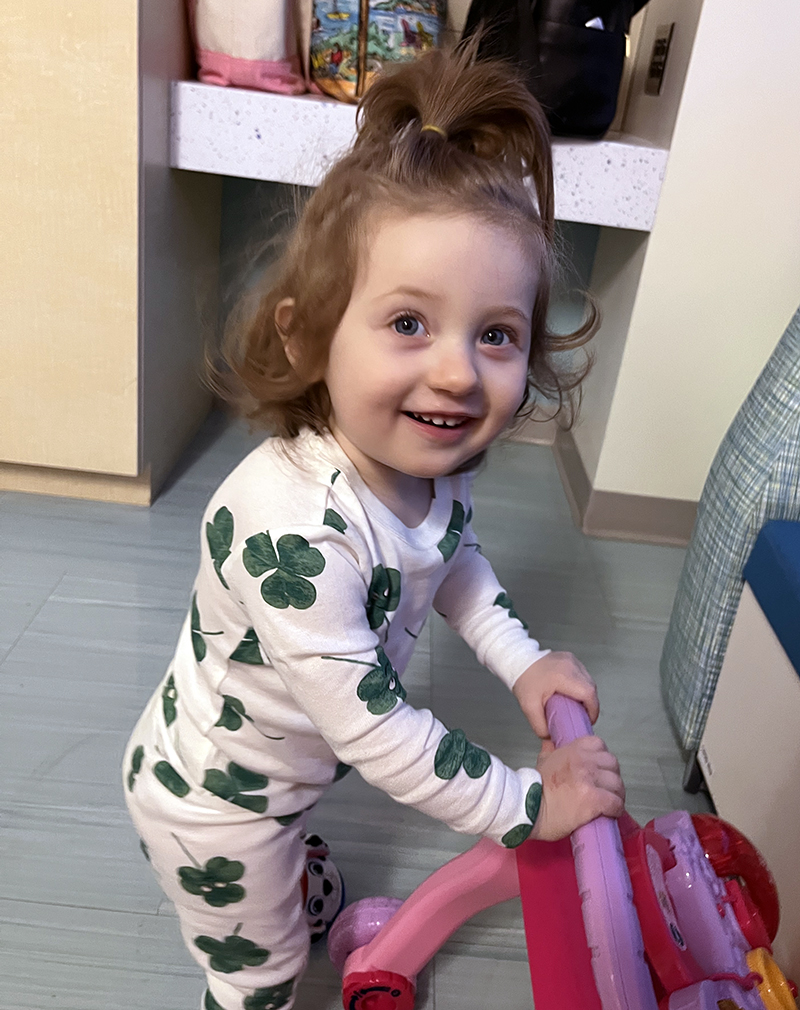Column: Navigating a ‘post-pandemic’ life with a toddler

Nearly one year to the day after receiving my first dose of the COVID-19 vaccine, I tested positive for the virus that has upended so many people’s lives.
More than two years into the pandemic, after all the safeguards, canceled plans and remote work, I finally joined the unfortunate ranks of nearly half a billion people worldwide to test positive.
On April 5, my wife and I arrived home from a quick getaway to Savannah, Ga., that doubled as a birthday celebration. It was only the second time we’ve flown since the pandemic. Last October, we visited family in Florida.
As we got home from JFK, my wife grabbed a pair of rapid at-home COVID-19 test kits. Our daughter had been staying at my in-laws, and before we picked her up, we wanted to make sure we were both negative.
My wife was negative. I was positive.
A sense of dread hit us both. Not so much for me. I’ve been fully vaccinated and boosted, and was confident the virus wouldn’t cause any serious issues.
Our focus shifted to our soon-to-be 20-month-old daughter, Winnie, who we’ve done so much to protect by limiting potential exposure as best as possible.
She was a pandemic baby, born in August 2020 shortly after the first major wave of COVID-19 cases had subsided. She spent two weeks at Morgan Stanley Children’s Hospital in New York City after undergoing open heart surgery to correct a condition known as dextro-Transposition of the Great Arteries. She bounced back in incredible fashion after undergoing the surgery at just 2 days old. I shared some of her story on these pages back then and, in the time since, she continues to amaze us as she grows into an independent, adventurous and cheerful little girl.
Around her first birthday, we began sending her to daycare for two days a week out of necessity. As any parent who has sent kids to daycare can attest, it didn’t take long for her to get sick. Starting around late August, she kept dealing with respiratory issues that never seemed to fully go away. In late September, we finally had to take her to the emergency room and she was diagnosed with pneumonia on top of three viruses. Her oxygen levels had dipped, which kept her hospitalized for a few days.
After some antibiotics to treat the pneumonia, she was discharged and we left Stony Brook Children’s Hospital, figuring we wouldn’t be back anytime soon.
But in December, just a few weeks before Christmas, she got sick again. Back to the ER we went and she was hospitalized. Most recently, in early March, she got sick once more and spent a few more nights at Stony Brook.
The children’s hospital started to become a second home.
We learned early on during all these hospital visits that our daughter likely has an asthma issue. Doctors referred to it as reactive airway disease, since asthma itself can’t be concretely diagnosed in children as young as our daughter. But we knew that when she gets a respiratory virus, her airways close up and she struggles to breathe and maintain normal oxygen levels.

We learned how to give her an inhaler with a medicine called Albuterol that helps treat her breathing when she’s feeling sick. Her pediatrician, in consultation with a pulmonologist, prescribed another inhaler medication that we now give her twice a day as a longterm solution. So far, it seems to be working well.
When she was hospitalized most recently, she had tested positive for a coronavirus known as OC43, which is basically a common cold. Most kids would suffer mild symptoms and be back running around in no time.
Our daughter ended up on a high-flow nasal cannula in the pediatric intensive care unit.
Looming over everything has been the potential for COVID-19. As restrictions have eased back to a nearly pre-pandemic time, we’re left to wonder how exactly to navigate going forward.
No vaccines are available for children under 5 yet. And the country, weary of two years of major inconveniences such as wearing a surgical mask in the grocery store, has largely moved on from the pandemic. Just this week, a federal judge overturned the mask requirement for public transportation, defying recommendations from the Centers for Disease Control and Prevention. If I hadn’t been wearing an N-95 mask on the plane earlier this month, I could have easily been unknowingly spreading Covid-19 on our flight.
Our family hasn’t exactly lived in a bubble these past two years, but the small safeguards in place such as mask wearing in indoor public spaces helped us avoid the virus for more than two years and keep our daughter protected. It becomes a fine line to balance, navigating life returning to normal while knowing our daughter could very well be hospitalized or worse if she contracts Covid-19.
Luckily by using the rapid test, I was able to avoid exposing my daughter this time. I spent the rest of that week isolated in our bedroom and then wore a mask for several days after that.
Thanks to vaccinations, the worst of the pandemic is undoubtedly behind us from an overall perspective as we move into an endemic stage.
But for parents like myself with young children, and particularly those whose children suffer from respiratory issues, that threat won’t be entirely gone anytime soon. All we can do is wait for the vaccine and take precautions wherever possible. Until then, we’ll be on our own in a country that has decided its done with Covid-19.








